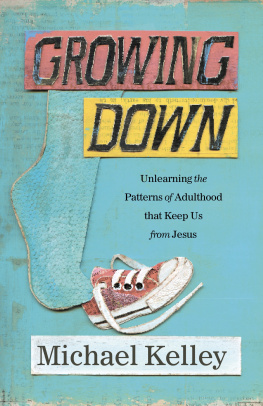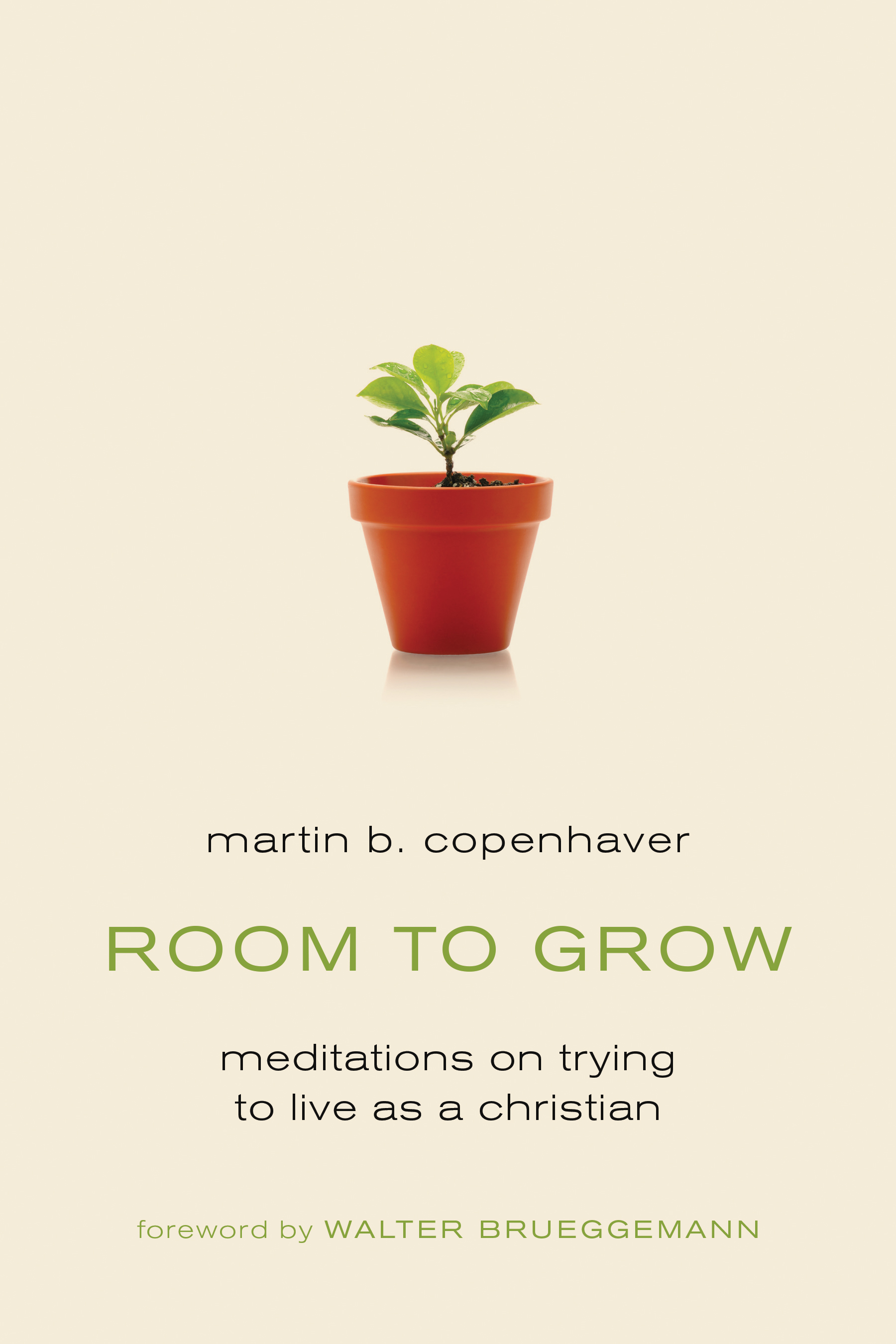In these beautifully crafted meditations, we are invited to discern our calling, to pray without ceasing, to be taught by death. But most of all, we are invited to seek the presence of God in our lives and in the world. Martin Copenhaver gently awakens us to Gods presence pulsing even through the awkward silences of our prayers and our clumsy attempts to care for one another. Each chapter is a benediction good words offered in blessing.
Stephanie Paulsell
Harvard Divinity School
Imagine a long walk with an old friend or an evening around a fireplace with a mentor you have long loved and admired. Thats something of what it feels like to read Martin Copenhavers moving and inspiring meditations in this book.... A rare storyteller and a warm, wise guide, Copenhaver makes Christian faith seem real, challenging, enormously heartening, and best of all joyful. What a gift to have this book to go back to again and again!
Samuel T. Lloyd III
Trinity Church Boston
Room to Grow
Meditations on Trying
to Live as a Christian
Martin B. Copenhaver
W illiam B. E erdmans P ublishing C ompany
Grand Rapids, Michigan / Cambridge, U.K.
2015 Martin B. Copenhaver
All rights reserved
Published 2015 by
W m. B. E erdmans P ublishing C o.
2140 Oak Industrial Drive N.E., Grand Rapids, Michigan 49505 /
P.O. Box 163, Cambridge cb 3 9 pu U.K.
Printed in the United States of America
Library of Congress Cataloging-in-Publication Data
Copenhaver, Martin B., 1954
Room to grow : meditations on trying to live as a Christian /
Martin B. Copenhaver.
pages cm
ISBN 978-0-8028-7258-6 (pbk. : alk. paper)
eISBN 978-1-4674-4292-3 (ePub)
eISBN 978-1-4674-4252-7 (Kindle)
1. Christian life Meditations.
I. Title.
BV4501.3.C6795 2015
242--dc23
2015022774
www.eerdmans.com
This book is dedicated to Village Church.
Because it takes two to gospel.
Contents
I magine that you are a pastor . You must plan the funeral for the guy in the parable in Luke 12 who tore down his barns to build bigger barns, and then was surprised by death in the night. You have a conversation with his widow. She tells you what a fine man he was, with such good intentions. He never got around to some of those good intentions, because he always had one more barn to build. You reflect on the conversation and conclude, Death is a teacher.
This remarkable act of interpretative imagination is done by Martin Copenhaver in the opening meditation in this volume. It is remarkable, but Martin does it regularly. That meditation is typical of the way in which he moves us toward the zinger of the biblical text without our noticing until it takes us by surprise.
Martin is no celebrity preacher. He easily could have been. But he had a different calling: to be a pastor of a local congregation, and he has done that faithfully and effectively for a long time. One can sense in these understated, compelling meditations that he is a pastor who has put his bucket down in a congregation in his case, an alert assembly with high expectations. One can see the sly ways in which he enters into the life and presence and struggles and choices of his congregation that he himself shares with them. This is a preacher in solidarity!
He is a storyteller. But the stories he tells couldnt be mistaken for sermon illustrations. Rather, they are stories that surprise us by disclosing a dimension of possibility in real life that we hadnt noticed. Sometimes the stories begin with Scripture. Sometimes they start with Martins own experience or memory as his own concealed thought is revealed. Sometimes they start with what he has noticed or been told about the folks around him. However they start, by the time they finish, we find that our life has been reimagined before our very eyes. His way of re-narrating our life is gentle and done in small bits. What comes through in a cumulative way, however, is the sense that the life we are living need not be the one we continue to live. There is another way; there is another story to perform and tell through our lives. It is a story of grace and risk and neighborliness and generosity. Wise as he is, Martin is never didactic or coercive or capable of reprimand, precisely because he expects his listeners to understand and to care about what hes talking about, and to do some of the work themselves.
Thus he can imagine, for example, that he can hear what he calls the choir practice when Paul and his companions are in jail in the book of Acts. He notices that they dont rant or protest; they sing. That ancient report suggests to Martin that it is the work of our lives to locate and identify a song that is deep enough and large enough to be worth singing in the hard places of life. This cannot be a superficial pop song. It must be a song of deep love grounded beyond ourselves. By the time he finishes this act of uncommon imagination, we ourselves can hear something of the ancient jail cadences of gospel freedom. Better than that, we are ready to join the choir in the awareness that the old, old story often becomes the new, new song.
Now this quintessential pastor/preacher has been appointed president of a historic seminary. No one knows yet if he can raise all the money that he will be required to raise. No one knows yet if he will lead his school to a curriculum appropriate to our new, bewildering moment in Gods history. But all at the seminary will know that this preacher invites them to reimagine their lives and their school according to the true narrative of Gods uncompromising purpose for us. We readers will come to know the same with gratitude and appreciation in these meditations.
Walter Brueggemann
Columbia Theological Seminary
A s a boy, when I went shopping for clothes with my mother, she would always ask me to try on items that were about a size too large to fit me perfectly. If the shoe-sizing contraption indicated that I was a size 4, she would ask the store clerk to bring a size 5 for me to try on. If the jeans I tried on were a bit long, she considered them just right because they left me room to grow. Until I grew into them, I could fold over the pant legs at the bottom, creating a makeshift cuff not much of a fashion statement, to be sure, but at least that way I wouldnt need another pair of jeans quite so soon.
Wearing clothes that dont fit perfectly can make you look and feel foolish at times, but it also makes a statement to the world that you intend and expect to continue growing. Its not a fashion statement. Its an aspirational statement.
That is how I understand the Apostle Pauls admonition to the Romans: Put on the Lord Jesus Christ (NRSV), also translated as Dress yourself with the Lord Jesus Christ (CEB). Paul is asking the Romans to assume some of the qualities of Christ, to wear them as they would a new set of clothes.
Thats quite a charge. I dont know if the Romans felt up to it. What I do know is that when I try Jesus on for size and look in the mirror, sometimes I can get quite discouraged. When I dress myself with Jesus, I can feel like that boy whos trying to wear an outfit thats at least a size too large. Or, perhaps even more, I can feel like a boy in the attic trying on my fathers clothes. Not only do I feel awkward; I can even look a bit silly.
Then I remember my mother insisting that, when trying on a new outfit, its very important to leave room to grow. What seems to cause me to trip all over myself today allows for the possibility of growth. And when I clothe myself with Jesus, he leaves me room to grow which is a good thing because, God knows, Im still growing. I put on Jesus as I would a new and ill-fitting outfit in order that someday it might fit and be a fitting expression of who I have become.











